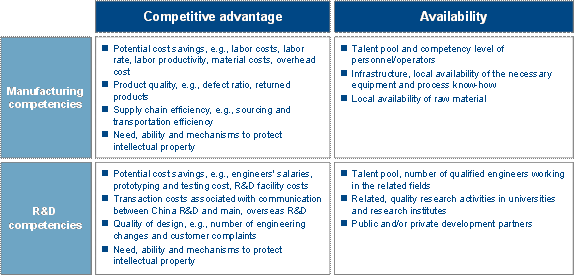
|
BIZCHINA> Review & Analysis
 |
|
Fitting China into your global footprint
(chinadaily.com.cn)
Updated: 2008-05-23 15:20 2. Define fit in terms of both competitive advantage and availability Once you have unbundled the competencies embedded in your current and future product portfolio, you can assess their "China fit". In essence, two factors determine "fit": · The potential competitive advantage China offers, i.e. can you develop and exploit the competency more cheaply or effectively in China than elsewhere? Competitive advantage is not only a matter of cost or even quality-adjusted cost. It also depends on other criteria such as IP risk, transaction costs and supply chain efficiency. The region where a competency is widely spread at a high quality level may not be the location you had in mind initially. · The availability of the competency within China, i.e. how accessible are the people, infrastructure, materials and development partners required to develop and exploit the competency? The best-fitting competencies are those for which China offers a strong competitive advantage and that are securely available (see Exhibit 3). Exhibit 3: Criteria to assess competitive advantage and availability of competencies
 When assessing "fit", it is important to define competencies at the right level of granularity. Take, for example, the case of embedded software development. When looking at the vast talent pool and multitude of potential partners for embedded software development in China, one may conclude that availability is high. But when zooming in on the issue, one will see that the greater part of embedded software activities relates to telecommunications and mobile phone applications in particular. Furthermore, in many cases, software development is carried out by small companies lacking the critical mass required to deliver the expected quality. In other words, a company looking for embedded software competencies should specify its needs more precisely: software for telecommunications is different from software to control, say, a robotics arm. It is also important to reframe the competencies in a Chinese context. Take, for example, the case of detection and removal of faulty components from a conveyor belt. In Europe, these processes are highly automated. Simply copying the European automated process into a Chinese facility may not lead to substantial cost advantages. Greater cost advantages can instead be obtained by using manual labor for process steps that are not quality-critical. At the end of the process, possible human errors are avoided by cross-checking the bar codes of manually removed components with the barcodes of products that were labeled as faulty by the testing device. You can thus deliver similar quality, but at a reduced cost. (For more biz stories, please visit Industries)
|
a级毛片av无码